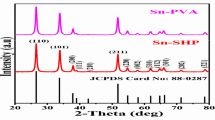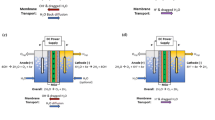Abstract
Hydrophilic UiO-66 crystals with superior water adsorption ability were synthesized and incorporated into the polyimide (PI) membrane for efficient aprotic solvent separation via pervaporation. The effect of the different UiO-66 addition in the pyromellitic dianhydride (PMDA)-2, 2-bis[4-(4-amlnophenoxy)phenyl]propane (BAPP)-based PI membrane on the membrane structure, thermal stability, surface hydrophilicity, solvent-resistant, and pervaporation performance was systematically studied. The UiO-66/PI hybrid membranes with small amount content (2 wt%) exhibited high hydrophilicity and excellent swelling resistance due to the superb dispersion benefiting from the excellent complexation of UiO-66 and PI chain. The effects of operational variables such as operating temperature and concentration of feed solution on the pervaporation separation performance of the hybrid membranes with different UiO-66 loadings were investigated. When the mass fraction of UiO-66 was 2 wt%, the hybrid membranes show the permeation flux of 109.7 and 57.1 g/(m2h) and separation factor of 34.1 and 133.9, respectively, for DMF/H2O and DMAc/H2O systems.

Graphical abstract











Similar content being viewed by others
Abbreviations
- BAPP:
-
2,2-Bis[4-(4-amlnophenoxy)phenyl]propane
- DMAc:
-
N,N-dimethylacetamide
- DMF:
-
N,N-dimethylformamide
- FTIR:
-
Fourier-transform infrared
- PAA:
-
Poly(amic acid)
- PI:
-
Polyimide
- PMDA:
-
Pyromellitic dianhydride
- PV:
-
Pervaporation
- SD :
-
Swelling degree
- TGA:
-
Thermogravimetric analysis
- XRD:
-
X-ray diffraction
- A p :
-
Pre-exponential factor
- R :
-
Gas constant
- M s :
-
Weights of swollen membranes (g)
- M d :
-
Weights of dry membranes (g)
- J :
-
Permeation flux (g m−2 h−1)
- E P :
-
Apparent activation energy (kJ/mol)
- T :
-
Feed temperature (K)
References
Cao KT, Jiang ZY, Zhao J, Zhao CH, Gao CY, Pan FS, Wang BY, Cao XZ, Yang J (2014) Enhanced water permeation through sodium alginate membranes by incorporating graphene oxides. J Membr Sci 469:272–283
Cavka JH, Jakobsen S, Olsbye U, Guillou N, Lamberti C, Bordiga S, Lillerud KP (2008) A new zirconium inorganic building brick forming metal organic frameworks with exceptional stability. J Am Chem Soc 130:13850–13851
Chapman PD, Oliveira T, Livingston AG, Li K (2008) Membranes for the dehydration of solvents by pervaporation. J Membr Sci 318:5–37
Chen CF, Huang XG, Qin WM (2007) Preparation, characterization and thermal decomposition of polyimides with main chain containing cycloaliphatic units. J Macromol Sci B 47:109–116
Das S, Banthia AK, Adhikari B (2006) Pervaporation separation of DMF from water using a crosslinked polyurethane urea-PMMA IPN membrane. Desalination 197:106–116
Devi DA, Smitha B, Sridhar S, Aminabhavi TM (2006) Pervaporation separation of dimethylformamide/water mixtures through poly(vinyl alcohol)/poly(acrylic acid) blend membranes. Sep Purif Technol 51:104–111
Elshof JE, Abadal CR, Sekulić J, Chowdhury SR, Blank DHA (2003) Transport mechanisms of water and organic solvents through microporous silica in the pervaporation of binary liquids. Microporous Mesoporous Mater 65:197–203
Flynn EJ, Keane DA, Tabari PM, Morris MA (2013) Pervaporation performance enhancement through the incorporation of mesoporous silica spheres into PVA membranes. Sep Purif Technol 118:73–80
Grimaldi J, Imbrogno J, Kilduff JC, Belfort G (2015) New class of synthetic membranes: organophilic pervaporation brushes for organics recovery. Chem Mater 27:4142–4148
Huang Y, Baker RW, Vane LM (2010) Low-energy distillation-membrane separation process. Ind Eng Chem Res 49:3760–3768
James SL (2003) Metal-organic frameworks. Chem Soc Rev 32:276–288
Katz MJ, Brown ZJ, Colón YJ, Siu PW, Scheidt K, Snurr RQ, Hupp JT, Farha OK (2013) A facile synthesis of UiO-66, UiO-67 and their derivatives. Chem Commun 49:9449–9451
Khosravi T, Mosleh S, Bakhtiari O, Mohammadi T (2012) Mixed matrix membranes of Matrimid 5218 loaded with zeolite 4A for pervaporation separation of water-isopropanol mixtures. Chem Eng Res Des 90:2353–2363
Kurkuri MD, Aminabhavi TM (2004) Polyacrylonitrile-g-poly(vinyl alcohol) membranes for the pervaporation separation of dimethylformamide and water mixtures. J Appl Polym Sci 91:4091–4097
Li YF, He GW, Wang SF, Yu SN, Pan FS, Wu H, Jiang ZY (2013) Recent advances in the fabrication of advanced composite membranes. J Mater Chem A 1:10058–10077
Li QQ, Liu Q, Zhao J, Hua YY, Sun JJ, Duan JG, Jin WQ (2017) High efficient water/ethanol separation by a mixed matrix membrane incorporating MOF filler with high water adsorption capacity. J Membr Sci 544:68–78
Ma WZ, Li TY, Jiang C, Zhang P, Deng L, Xu R, Zhang Q, Zhong J, Matsuyama H (2019) Effect of chain structure on the solvent resistance in aprotic solvents and pervaporation performance of PMDA and BTDA based polyimide membranes. J Membr Sci 584:216–226
Morigami Y, Kondo M, Abe J, Kita H, Okamoto K (2001) The first large-scale pervaporation plant using tubular-type module with zeolite NaA membrane. Sep Purif Technol 25:251–260
Nik OG, Chen XY, Kaliaguine S (2012) Functionalized metal organic framework-polyimide mixed matrix membranes for CO2/CH4 separation. J Membr Sci 413−414:48–61
Othman MBH, Ramli R, Ariff ZM, Akil HM, Ahmad Z (2012) Thermal properties of polyimide system containing silicone segments. J Therm Anal Calorim 109:1515–1523
Shah D, Kissick K, Ghorpade A, Hannah R, Bhattacharyya D (2000) Pervaporation of alcohol–water and dimethylformamide-water mixtures using hydrophilic zeolite NaA membranes: mechanisms and experimental results. J Membr Sci 179:185–205
Shen J, Liu GP, Kang H, Li QQ, Guan KC, Li YK, Jin WQ (2016) UiO-66-polyether block amide mixed matrix membranes for CO2 separation. J Membr Sci 513:155–165
Shi GM, Yang TX, Chung TS (2012) Polybenzimidazole (PBI)/zeolitic imidazolate frameworks (ZIF-8) mixed matrix membranes for pervaporation dehydration of alcohols. J Membr Sci 415-416:577–586
Solaka EK, Asmanb G, Camurluc P, Sanlı O (2008) Sorption, diffusion, and pervaporation characteristics of dimethylformamide/water mixtures using sodium alginate/polyvinyl pyrrolidone blend membranes. Vacuum 82:579–587
Sorribas S, Kudasheva A, Almendro E, Zornoza B, IglesiaÓ TC, Coronas J (2015) Pervaporation and membrane reactor performance of polyimide based mixed matrix membranes containing MOF HKUST-1. Chem Eng Sci 124:37–44
Su NC, Sun DT, Beavers CM, Britt DK, Queen WL, Urban JJ (2016) Enhanced permeation arising from dual transport pathways in hybrid polymer-MOF membranes. Energy Environ Sci 9:922–931
Tang J, Sirkar KK (2012) Perfluoropolymer membrane behaves like a zeolite membrane in dehydration of aprotic solvents. J Membr Sci 421-422:211–216
Tran NT, Kim J, Othman MR (2019) Microporous ZIF-8 membrane prepared from secondary growth for improved propylene permeance and selectivity. Microporous Mesoporous Mater 285:178–184
Valenzano L, Civalleri B, Chavan S, Bordiga S, Nilsen MH, Jakobsen S, Lillerud KP, Lamberti C (2011) Disclosing the complex structure of UiO-66 metal organic framework: a synergic combination of experiment and theory. Chem Mater 23:1700–1718
Venna SR, Lartey M, Li T, Spore A, Kumar S, Nulwala HB, Luebke DR, Rosi NL, Albenze E (2015) Fabrication of MMMs with improved gas separation properties using externally-functionalized MOF particles. J Mater Chem A 3:5014–5022
Wang T, Shen JN, Wu LG, Bruggen BV (2014) Improvement in the permeation performance of hybrid membranes by the incorporation of functional multi-walled carbon nanotubes. J Membr Sci 466:338–347
Wang NX, Zhang GJ, Wang L, Li J, An QF, Ji SL (2017) Pervaporation dehydration of acetic acid using NH2-UiO-66/PEI mixed matrix membranes. Sep Purif Technol 186:20–27
Wu GR, Jiang MC, Zhang TT, Jia ZQ (2016) Tunable pervaporation performance of modified MIL-53(Al)-NH2/poly(vinyl alcohol) mixed matrix membranes. J Membr Sci 507:72–80
Xie W, Pan WP (2001) Thermal characterization of materials using evolved gas analysis. J Therm Anal Calorim 65:669–685
Xu YM, Chung TS (2017) High-performance UiO-66/polyimide mixed matrix membranes for ethanol, isopropanol and n-butanol dehydration via pervaporation. J Membr Sci 531:16–26
Xu R, Guo M, Wang J, Zhang Q, Zhong J (2016) Fabrication of solvent-resistant copolyimide membranes for pervaporation recovery of amide solvents. Chem Eng Technol 41:337–344
Funding
This research was supported by the National Natural Science Foundation of China (21406017); China Petroleum & Chemical Corporation Science and Technology Project (216078); The Natural Science Foundation of the Jiangsu Higher Institutions of China (18KJA430005, 18KJA530001); Postgraduate Research & Practice Innovation Program of Jiangsu Province (KYCX18_2614); The Priority Academic Program Development of Jiangsu Higher Education Institutions (PAPD), and the Top-notch Academic Programs Project of Jiangsu Higher Education Institutions (TAPP); Advanced Catalysis and Green Manufacturing Collaborative Innovation Center, Changzhou University.
Author information
Authors and Affiliations
Corresponding authors
Ethics declarations
Conflict of interest
The authors declare that they have no conflict of interest.
Additional information
Publisher’s note
Springer Nature remains neutral with regard to jurisdictional claims in published maps and institutional affiliations.
Electronic supplementary material
ESM 1
(DOC 861 kb)
Rights and permissions
About this article
Cite this article
Ma, W., Li, T., Zhang, Q. et al. Preparation of hybrid membranes by incorporating hydrophilic UiO-66 nanoparticles for high-performance pervaporation dehydration of aprotic solvents. J Nanopart Res 22, 64 (2020). https://doi.org/10.1007/s11051-020-4778-9
Received:
Accepted:
Published:
DOI: https://doi.org/10.1007/s11051-020-4778-9




